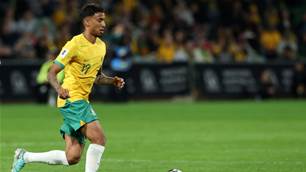Ange Postecoglou and the Socceroos will be hoping that a 1-1 draw in the first leg will be enough to set up Tuesday’s return leg in their favour.
The control enjoyed in the first half quickly swung towards the Syrians in the second, although the game could have been killed off earlier had a number of missed opportunities been converted.
Formations
Much to the ire of the Syrian media, coach Ayman Al Hakeem left legend and current captain Firas Al Khatib on the bench. Al Khatib is widely considered to be Syria’s best ever footballer, having scored 27 goals in 58 games for his country. Omar Khibrin and Omar Al Soma, both based in Saudi Arabia, started the match up front with a combined total of 18 international goals between them in 44 matches. Mahmoud Al Mawas, who at just 24 years of age already has 46 caps for his country, started in midfield alongside one of the other young Syrian bolters, Khaled Al Mobayed. Between the three experienced defenders, there were a combined total of 89 international appearances, ensuring a tough challenge for Australia.

Figure 1: Formations and general movement tendencies
Despite earlier speculation suggesting a change reverting to the previous system built around a 1-4-3-3, Ange persisted with the set-up that has been put under much scrutiny by the pundits in recent times. However, some names appeared in different positions than usual, with Mat Leckie taking up a role as an attacking midfielder on the inside, with Josh Risdon taking the latter’s regular position on the right flank. Aziz Behich started ahead of Brad Smith on the left-hand side, with Mooy and Milligan anchoring the box midfield. Matthew Jurman was given his first ever international cap after
good form with Suwon Bluewings in South Korea, starting alongside regulars Trent Sainsbury and Milos Degenek. The ever-present Mat Ryan maintained his position in goals, with Tomi Juric doing the in his advanced position.
Syria’s transition from attack to defence
Syria’s shape whilst in possession seemed to be geared towards equalising the press of Australia, and it was clear that significant portions of their tactical approach was aimed at minimising the threats their opposition posed. This was the same when it came to the team being out of possession, with a transition to a back four with packed central areas. As illustrated below, the movements occurred as follows:
· The opposite winger would drop to become the opposite fullback in a back four;
· The furthest striker from the ball would drop into a higher midfield role;
· The attacking midfielder would drop deeper into a more compact midfield; and,
· The closest winger would drop alongside the central midfield players after initially trying to force a backwards pass.

Figure 2: Syria's transition between the shapes in and out of possession
Loading the midfield with so many players allowed for the tracking of the runs of Robbie Kruse and Mat Leckie, who would frequently burst forward from their deeper positions between the lines to exploit the space behind the Syrian defence.
Potential error in the funnelling of possession
Whether it is known by a team or not, their defensive set up offers up a path to progress with the ball as well as limiting an option. It is a trade-off, as with any other tactical decision. The better the team, the more aware they are of the space they are conceding and set themselves up accordingly in order
to best manage the risk v reward the tactical trade-off provides. For example, if a team places priority on preventing ball circulation to the wider areas, they will naturally concede space in the middle of the pitch by default. However, good teams will set pressing traps in these inviting areas, capitalising on the situation and potentially recovering the ball.

Figure 3: Syria's conceding of space in different areas
With this in mind, Syria took a peculiar approach to this concept. Their defensive set up was largely separated into two operations, as highlighted above. The front three players (in the blue region above) would cut off passing lines backwards to the centre-back, as well as cutting easy access to the fullbacks. As a result, Australia were invited to play centrally and build up through one of Aaron Mooy or Mark Milligan. Conventionally, it is at this point where Syria will attempt to win the ball back, having forced possession into a preferable area. However, they then funnelled Australia wider, choosing instead to solidify the central area in front of goal. This lead to excessive space being made available for Behich and Risdon, and culminated in multiple opportunities being presented to Juric, Leckie and Kruse. It is worth noting that this was likely a break down in the game model, as after the interval this error was no longer as apparent, with possession instead being funnelled to wider areas earlier, where Syria would then look to press and corner Australia, culminating in more defensive success than in the first half.
Changes in the box midfield
The box midfield has been covered fairly extensively in recent matches, but there were a few small alterations in player roles against Syria. Firstly, Postecoglou attempted to decrease the success of opposition counter attacks by increasing the available rest defence – where players position themselves defensively regardless of if their team is in possession or not. In this case, both of the deeper midfielders were generally positioned behind the ball when in and out of possession. This increased defensive solidity and certainly decreased the frequency and effectiveness of the Syrian
counter attack, but it also meant that because of the more conservative positioning of the midfielders it would be harder to overload areas higher up the pitch.

Figure 4: The two advanced midfielders were able to create more space
In possession, the role of the advanced midfielders also changed. Instead of being key components of build-up play, Leckie and Kruse prioritised forward movement between the lines. This movement dragged the defenders away from the central areas, and as a result Syria conceded ample space ofr Mooy and Milligan, as well as Risdon and Behich on the outside, to attack. This led to the creation of numerous chances in the first half, as well as offering space to maintain and control possession and therefore the temp and rhythm of the match.
Summary

Figure 5: Tactical summary (MIP = moment in possession, MOP = moment out of possession)
Syria looked to directly access wider areas of the middle third when they recovered the ball in their own half, looking for runs behind the Australian defensive line or for movement across the face of the near post. Without the ball, they prioritised the occupying of central areas, ensuring defensive overloads wherever possible. Australia maintained their approach to the match, utilising effective possession and looking for the movement of Kruse and Leckie behind the opposition defence wherever possible. As per usual, the aim was to recover the ball as quickly as possible whenever it was lost. The errors which Syria experienced in the first half were not as apparent after the break, which is a credit to Al Hakeem. On the balance of play, it could be said that a draw was a fair result, despite both teams having opportunities to kill the game off.
Related Articles

Socceroos midfielder embraces move to England

Cardiff City snap up sought-after Socceroos starlet













